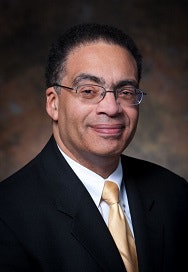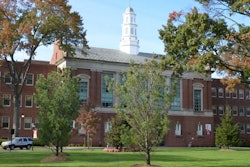WASHINGTON —Automation and other technological advancements threaten to put good-paying jobs further out of reach for marginalized groups unless more investments are made in preparing students for “Blue-Collar STEM” jobs, panelists convened Tuesday on Capitol Hill said.
Conversely, employers will need a more diverse pipeline of STEM talent in order compete, said panelist Dr. Victor McCrary, vice president for research and economic development at Morgan State University.
“This workforce is vital to the well-being of our society and the economic competitiveness of our nation,” McCrary said. “Businesses large and small across the U.S. — from Baltimore to the bayous of Louisiana — need adaptable, STEM-capable workers at every level of education and from all demographic groups in order to compete.”
 Dr. Victor McCrary
Dr. Victor McCraryMcCrary said 12 percent of all jobs require skilled technical workers — a figure he said represents a total of more than 16 million jobs.
“One of the challenges for workers in this new order is this job market is fast-moving and dynamic,” McCrary said “Workers can no longer expect to have the same job and do the same task year in and year out.”
He also noted that while 11.5 of the 11.6 million jobs created between 2010 and 2016 went to workers with at least some college education, the cost of a four-year degree continues to “grow by leaps and bounds, putting it out of reach for many Americans.”
“Given this landscape, the value of focusing our attention on blue-collar STEM education and workforce development is critical,” McCrary said. “Educational efforts aimed at developing a skilled technical workforce helps to produce the kind of highly capable workers in demand both in the private and public sector, typically in areas such as health care, cybersecurity, research and defense.”
McCrary defines blue-collar STEM as “the technical skills and infrastructure required for workers with less than a 4-year degree to contribute to and take full advantage of today’s economy.”
“These careers provide multiple pathways to the American dream,” McCrary said.
McCrary made his remarks Tuesday at a briefing on blue-collar STEM jobs hosted by the Congressional Black Caucus.
“We have a little crisis that people aren’t noticing about the future of work,” said U.S. Rep. Bobby Scott, D-Va., ranking member on the House Committee on Education and the Workforce. “A lot of people — because of technology and automation — are about to lose their jobs and don’t know it. And if we’re not prepared it will be a real crisis in America.”
Scott pointed to automation in the banking industry as evidence of “jobs just evaporating.”
“Now most people rarely go into a bank. The number of tellers have basically evaporated,” Scott said. “You’re doing direct deposit, you’re doing take a picture of your check, send it in. There are banks now with no branches, just all on the Internet.”
More than just low-tech jobs are at stake, Scott said, noting that even the jobs of radiologists and tax preparers are being threatened by the ability of companies to read X-rays and prepare taxes remotely. “A lot of jobs are vulnerable to evaporation and if you’re not ahead of the curve with lifelong learning, your job may evaporate,” Scott said. “But if you’re learning [for] the next one, you’re still in good shape.”
Scott said given the fact that more people will have to learn their next job mid-career, Congress needs to focus more on lifelong learning when it gets around to reauthorizing the Higher Education Act. Scott also stressed the need to do more to prepare students at the K-12 level for the changing economy.
Other speakers echoed that concern when it comes to computer science — arguing that it’s better to introduce students to computer science sooner rather than later. They noted that the Trump administration recently announced $200 million in grants for computer science education.
Several speakers cited the need to break down barriers and destroy stereotypes concerning which student demographics are able to exceed in computer science.
For instance, Dr. Steve McGee, a representative of the Chicago Alliance for Equity in Computer Science, or CAFECS, said too often students with a background such as his — which featured family support and early exposure to computer science — are expected to have innate ability. Those without prior computer science experience — primarily women and minorities — are often steered away from computer science and other STEM courses.
McGee credited Chicago’s Computer Science for All initiative with helping to turn things around.
The initiative — which arose from a program developed by the University of California, Los Angeles — makes computer science a graduation requirement. Students take a course called ECS —Exploring Computer Science — which McGee said “empowers students to use computers to make meaning of their world.”
He said some 9,000 Chicago students — 85 percent African American and Hispanic and 40 percent female students — have completed the ECS course since the program was implemented in Chicago back in 2011.
“Analysis shows there’s no difference in performance based on gender and race,” McGee said.
Pat Yongpradit, chief academic officer at code.org — a non-profit dedicated to expanding access to computer science for women and underrepresented minorities — cited statistics that show 73 percent of STEM job growth through 2024 will be in computing science.
“K-12 is how we’re going to have to tackle this if we’re gonna catch up through workforce development initiatives,” Yongpradit said.
Jamaal Abdul-Alim can be reached at [email protected]. You can follow him on Twitter @dcwriter360



















